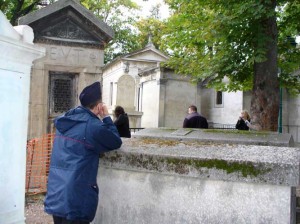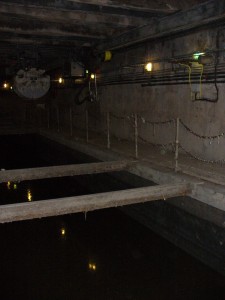
Asphalt layers, Paris, 1899-1900, by Eugène Atget (From the website of the National Gallery of Art, Washington).
Yesterday a friend and I visited the exhibition Eugene Atget: Old Paris at the Art Gallery of New South Wales. As the small catalogue that comes with your ticket says, Atget relentlessly tracked down the vestiges of ‘Old Paris’ with his tripod-mounted camera. Between 1898 and 1927 he photographed everyday views of shopfronts, signs and street posters, courtyards, interiors, gardens, statues, docks and bridges. Many of these were destined for demolition but some still exist today.
Naturally I was just as interested in the surfaces of the streets as I was in the buildings that lined them, especially when Atget had captured them glistening with rain. Most of those in the photographs were cobbled, the narrow streets and laneways either sloping to drains in the centre, or cambered to kerb and guttering on either side. Not all of those with kerbs had sidewalks wide enough to walk along. In those times the whole width of the street was available to everyone – horse-drawn vehicles and handcarts, peddlers, bicyclists, strollers and shoppers. It was only with the advent of the motor car that pedestrians were irrevocably pushed to the side of the street.
For most of Atget’s career as a photographer, people appeared almost incidentally in his streetscapes. But in the early years he had often made people the subject of his pictures, recording disappearing trades and occupations. One of those early photographs shows  asphalt layers, or ‘bitumiers’, working on their hands and knees with hot asphalt and playing a part in the grand scheme to modernize the streets of Paris. You can read more about this photograph at Atget: The art of documentary photography on the website of the National Gallery of Art, Washington.
The exhibition at the Art Gallery of New South Wales runs until 4 November 2012. The framed photographs in the exhibition are not enlarged but are prints that Atget made directly from his glass negatives, around 22 x 17 cm in size. My friend and I spent four hours scrutinizing and chatting about all of the images. We have compiled a suggested list of equipment that anyone contemplating a visit should take along.
Reading glasses (for close examination of the photographs)
A magnifying glass (ditto)
A map of Paris
A French dictionary (mainly to work out what kind of businesses all those signs were advertising and what the street vendors were selling)
A folding chair or, better still, a wheelchair that you and your companion can take turns in using
A stepladder (for looking at those photographs that are hung a little too high)



















